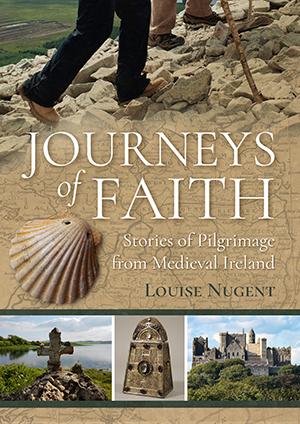JOURNEYS OF FAITH: stories of pilgrimage from medieval Ireland
Published in Book Reviews, Book Reviews, Issue 4 (July/August 2020), Reviews, Volume 28LOUISE NUGENT
Columba Books
€26.99
ISBN 9781782183723
Reviewed by Meredith Cutrer
Meredith Cutrer is a Ph.D student in University College Dublin’s School of History.

One need not have spent much time studying medieval Ireland to appreciate that the Irish landscape is imbued with the sacred. As the number of holy sites attest, religion has long been a powerful force in shaping the Irish imagination and has consequently fostered an enduring tradition of pilgrimage both within Ireland and abroad.
Pilgrimage as a topic of academic inquiry has garnered considerable multidisciplinary attention and within medieval Irish studies has been the focus of several excellent works by historians and archaeologists, including Peter Harbison and Tomás Ó Carragáin. The risk of redundancy in examining this topic is always high, but Louise Nugent’s thoughtful monograph shows just how much further a careful examination of pilgrimage in medieval Ireland can go in capable hands.
As a significant constituent of medieval Irish religion, pilgrimage was notably diverse in terms of places, praxes and participants. Nugent begins her work by identifying three primary categories of medieval Irish pilgrimage before wisely setting tight parameters for her own study. She focuses on what she calls ‘universal’ pilgrimage, which entails a journey to and from a holy location, restricting her scope to the period between AD 600 and the Reformation. Her approach is thematic rather than chronological and primarily informed by her archaeological expertise.
Nugent’s monograph is divided into nine chapters. Chapter 1 provides a foundation for her discussion of localised medieval Irish pilgrimage, introducing readers to the varied types of physical structures, relics and even natural phenomena that they might see in association with pilgrimage sites. Though with a decidedly archaeological bent, Nugent supplements brilliantly here, as elsewhere, with medieval hagiographic and annalistic sources that add to—and, intriguingly, sometimes complicate—the archaeological record. Chapter 2 traces the routes of Irish pilgrims abroad, as well as the movement of saints’ cults across the Irish Sea. While foreign holy sites are treated briefly, the most extensive evidence for Irish pilgrims internationally is found in Britain and occupies the majority of this chapter.
Chapter 3 explicates the diverse motivations for medieval Irish pilgrimages, which range from seeking good health and performing penance to requesting help in finding misplaced keys. Chapter 4 covers the logistics of preparations, financially, socially, administratively and spiritually. Chapters 5 and 6 focus on Irish pilgrims within Ireland and abroad respectively. Nugent carefully weaves together narrative and archaeology to recreate the medieval journeys to iconic sites such as Croagh Patrick and St Patrick’s Purgatory in Chapter 5 and to Rome, Jerusalem and Santiago de Compostela in Chapter 6. The stories she relates, drawn usually from late medieval primary sources, tell of perilous journeys for Irish devotees.
Chapter 7 turns from sacred space towards sacred time and considers the importance of the Church’s calendar, particularly a saint’s feast-day, in planning a pilgrimage. Nugent also explores the manner in which sacred objects, processions and performances played a central role in the pilgrim’s experience. The eighth chapter concerns the types of prayers and rituals in which pilgrims participated, and the offerings they left for the sake of healing and cleansing from sin. The final chapter concludes her study by examining the pilgrim’s return home, from the memorabilia that he or she acquired, sometimes found in the pilgrim’s grave, to the inspiration that the pilgrim brought back, which may have been the impetus for some artistic innovations in Ireland. Her book ends by revisiting a theme highlighted multiple times throughout her work—the continuity of many pilgrimage sites and practices in modern Irish life—though she notes that the motivations for the modern pilgrim may differ from those of his or her medieval forebears.
Nugent’s monograph boasts many strengths. She writes in an engaging and accessible style. Her effective use of storytelling keeps her study grounded in the real experiences of actual medieval pilgrims, making her book a pleasurable and gripping read. She is particularly mindful of including the numerous, though often overlooked, female and non-élite pilgrims as often as the evidence allows. One especially interesting observation that she highlights pertains to the distinction in chosen pilgrimage destinations based on class and gender. Lower classes seemed drawn to healing sites while the élite tended to prefer sites associated with non-healing miracles. Unsurprisingly, women overwhelmingly undertook local pilgrimages owing to familial and social obligations.
Journeys of faith features another exceptionally praiseworthy characteristic. As an archaeologist, Nugent understands the strong visual component to studies of place and landscape. While photographs would be expected in a work such as this, the sheer quantity and quality of photographs that this monograph contains are extraordinary: 170 full-colour photographs in total, plus ten maps, eleven black-and-white images and one chart. Nearly every other page features a full-colour photograph, and many pages have multiple colour photographs. The pictures enhance her study tremendously, and the book is nearly worth the price for the photographs alone.
Ireland has long enjoyed a vibrant culture of pilgrimage, and Nugent’s book is an erudite yet accessible exploration of this enduring religious practice. Journeys of faith is a highly recommended resource for all those with an interest in medieval Ireland and is well suited for both a specialist and a non-specialist reader.
















